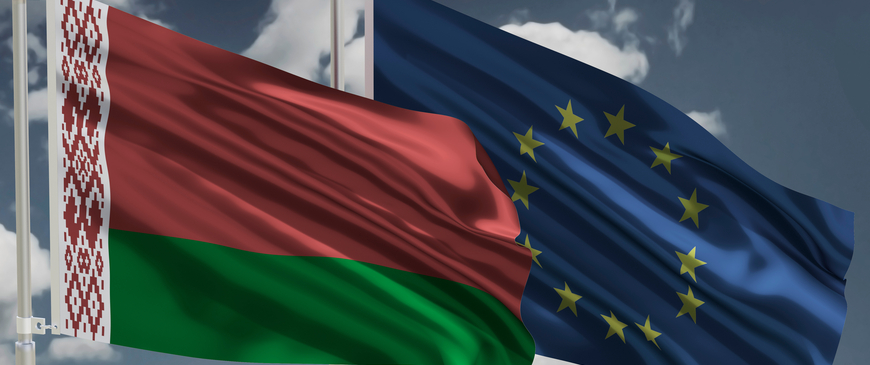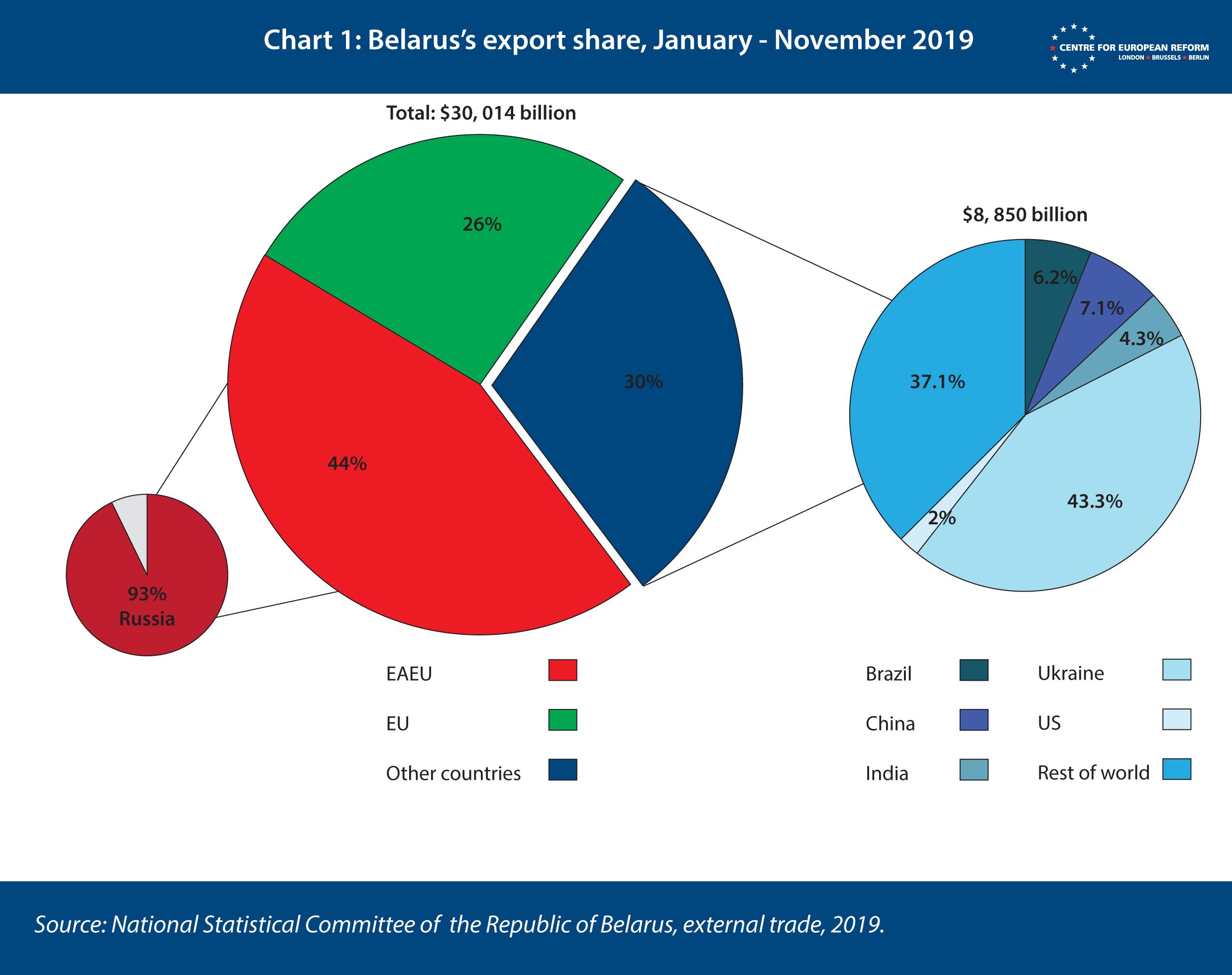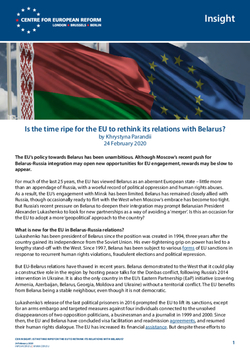
Is the time ripe for the EU to rethink its relations with Belarus?
The EU’s policy towards Belarus has been unambitious. Although Moscow’s recent push for Belarus-Russia integration may open new opportunities for EU engagement, rewards may be slow to appear.
For much of the last 25 years, the EU has viewed Belarus as an aberrant European state – little more than an appendage of Russia, with a woeful record of political oppression and human rights abuses. As a result, the EU’s engagement with Minsk has been limited. Belarus has remained closely allied with Russia, though occasionally ready to flirt with the West when Moscow’s embrace has become too tight. But Russia’s recent pressure on Belarus to deepen their integration may prompt Belarusian President Alexander Lukashenko to look for new partnerships as a way of avoiding a ‘merger’. Is this an occasion for the EU to adopt a more ‘geopolitical’ approach to the country?
The EU’s policy towards Belarus has been unambitious due to the country's close ties to Russia and domestic political repressions. But Russia's push for closer integration with Belarus may prompt the EU to rethink its approach, turning it into a more pragmatic engagement.
What is new for the EU in Belarus-Russia relations?
Lukashenko has been president of Belarus since the position was created in 1994, three years after the country gained its independence from the Soviet Union. His ever-tightening grip on power has led to a lengthy stand-off with the West. Since 1997, Belarus has been subject to various forms of EU sanctions in response to recurrent human rights violations, fraudulent elections and political repression.
But EU-Belarus relations have thawed in recent years. Belarus demonstrated to the West that it could play a constructive role in the region by hosting peace talks for the Donbas conflict, following Russia’s 2014 intervention in Ukraine. It is also the only country in the EU’s Eastern Partnership (EaP) initiative (covering Armenia, Azerbaijan, Belarus, Georgia, Moldova and Ukraine) without a territorial conflict. The EU benefits from Belarus being a stable neighbour, even though it is not democratic.
Lukashenko’s release of the last political prisoners in 2016 prompted the EU to lift its sanctions, except for an arms embargo and targeted measures against four individuals connected to the unsolved disappearances of two opposition politicians, a businessman and a journalist in 1999 and 2000. Since then, the EU and Belarus have concluded visa facilitation and readmission agreements, and resumed their human rights dialogue. The EU has increased its financial assistance. But despite these efforts to normalise the relationship, Belarus has remained low on the EU’s list of foreign policy priorities. Now Russia’s push for closer integration with Belarus, building on the 1999 treaty that on paper created a ‘Union State’ between the two, may persuade the EU to re-consider its approach.
The idea of reviving that treaty emerged in 2018, after Russia announced changes to the tax regime for the oil industry. Russia had provided substantial subsidies to Belarus through preferential energy prices, worth around $100 billion between 2005 and 2015. Heavily dependent on Russian oil for domestic consumption and re-export revenues, Belarus calculated that the tax changes would cost its exchequer over $10 billion by 2025, and demanded compensation. In response, Moscow said concessions would only be possible if the countries undertook far-reaching economic integration, including a unified tax and customs system.
Russia’s proposals present a dilemma for Lukashenko. Russia’s economy is almost 30 times larger than Belarus’s. Integration on Russian terms would undermine Belarus’s sovereignty and its efforts to pursue a ‘multi-vector’ foreign policy, balanced between East and West. Further integration is unpopular among Belarusians, with only 16.5 per cent of the population supporting the establishment of the Union State. And Lukashenko himself is trying to block any initiatives that might endanger Belarus’s independence, and thereby reduce his power. However, rejecting Moscow’s proposals would threaten Belarus’s fragile economy. Russia is Belarus’s largest creditor: as of mid-2019 Belarus owed Russia over $7.5 billion, equivalent to about 13 per cent of its annual GDP. The World Bank’s gloomy prediction of 1.2 per cent GDP growth for 2020-21 suggests that the Belarusian economy will not improve any time soon without substantial reform. But Lukashenko is unenthusiastic about economic liberalisation, as his domestic standing hinges on low levels of unemployment, less economic inequality than in other post-Soviet states, and generous social protection – all products of the non-market economy he has nurtured.
The pace of the Union State negotiations appears to have temporarily decelerated. During their last meeting on February 7th, President Vladimir Putin and Lukashenko again failed to agree on new energy contracts. Minsk has been pushing for a single energy market within the context of the Eurasian Economic Union (EAEU – Armenia, Belarus, Kazakhstan, Kyrgyzstan and Russia), so that it could buy oil and gas at Russian domestic prices. But Putin prefers to negotiate bilateral contracts with individual countries, as it provides him with political leverage. So Lukashenko’s dilemma persists: if Belarus wants to be less vulnerable to pressure from Moscow, it will have to pay more for its energy. Lukashenko therefore needs to look for new markets, lenders and energy suppliers.
Lukashenko’s regional power-play
For Belarus, Russia and the EU are not the only games in town. China and the US have also shown signs of interest in Belarus recently, thereby strengthening Lukashenko’s hand in his negotiations with Moscow. Belarus has made a concerted diplomatic push to deepen its economic, political and military relationship with China, whose credits have helped to reduce Minsk’s economic dependence on Russia. By 2017, Belarus owed China almost as much as Russia. Just days before Lukashenko met Putin on December 20th 2019, Belarus secured a conditionality-free $500 million loan from the Chinese Development Bank to help it repay foreign debts. That helped make up most of the difference after Russia had refused Belarus a $600 million loan.
If Belarus wants to be less economically dependent on Russia, it should look for new markets, lenders and energy suppliers. This may increase Lukashenko’s openness to co-operation with the EU, including on economic liberalisation and some governance reforms.
The US has also stepped up its involvement in Belarus, out of concern that Moscow’s integration push would threaten the country’s position as a ‘buffer zone’ on NATO’s eastern flank. In 2019, Washington and Minsk announced plans to exchange ambassadors for the first time in 10 years, and the first-ever visit of US Secretary of State, Mike Pompeo, followed in February 2020. Pompeo sent a symbolic message of support for Belarus’s sovereignty and signalled a willingness to step up economic co-operation, including the possibility of American oil supplies – an offer that may be of interest to Belarus if Russia starts charging market prices. The US is in principle keen to boost its development assistance and eventually lift US sanctions on Belarusian petrochemical companies, if Minsk progresses on democracy and human rights, which it is currently far from doing.
Still, regardless of how relations develop with China and the US, Belarus’s plans to reduce its dependence on Russia in the long term are impossible without closer ties to the EU. In 2016, Belarus placed export diversification at the heart of its economic security strategy, aiming to have at least 30 per cent of its exports going to each of the EAEU, the EU and the rest of the world. But the EU’s share is vulnerable to Russian pressure, as a quarter of Belarus’s exports consist of petroleum products made from Russian oil. This may increase Lukashenko’s interest in building more sustainable relations with the EU in other areas.

How the EU can step up engagement with Belarus
For the EU, the best scenario is that Belarus remains sovereign, independent and stable. The EU should consider how it can best engage with the country both economically and politically, and help it resist Russian pressure to implement the Union State. It may be difficult for the EU to forge a consensus on enhancing co-operation, as the EU already has experience of Belarus temporarily tilting towards it, only to reverse course when its relations with Russia improved. But the context is different now – Belarus is more desperate to diversify its economy than ever before, and China’s desire to increase its presence in the EU’s neighbourhood should also be a concern to the EU. Brussels will have to calibrate its policies carefully, avoiding options that could be seen as endorsing Lukashenko’s undemocratic regime. But there are ways in which the EU can support Belarus’s economy and encourage reform.
The EU could start by providing technical assistance for Belarus’s economic modernisation, as this would help attract investment from European firms. Belarus is the only EaP country that does not have a Partnership and Co-operation Agreement (PCA) with the EU, because of political and civil rights concerns. It also has been subject to trade restrictions since 2007. But Belarusians have some reason to feel harshly treated, given that Azerbaijan, ranked even lower in the Freedom in the World Index, is currently negotiating to replace its PCA with a new comprehensive agreement.
Following a thaw in relations in 2015-16, Minsk and Brussels started to negotiate a document on ‘partnership priorities’, setting out a framework for their collaboration in various areas, potentially including new trade arrangements. The process has been bumpy, largely due to Lithuania’s objection to the construction of a Russian-financed nuclear power plant in Ostrovets in Belarus, just 50 km from Vilnius. But Lithuania might soften its position if Lukashenko accepts strict inspections of the power station, which the European Commission can help to arrange. The EU should promptly move ahead with concluding the partnership priorities.
As the EU is currently revising its EaP framework, future spending for Belarus should reflect the Commission’s wider priorities, in particular the green economy and energy efficiency. Both parties would benefit from establishing a formal framework for discussing energy issues, given the importance of Belarus as a transit country, accounting for 10 per cent of Europe’s oil and 6 per cent of its gas. Belarus has signified its interest in projects to increase connectivity, boost digitisation and innovation, and facilitate trade. Some EaP projects are carried out bilaterally, and others multilaterally. So far Belarus has been keener to work in the multilateral format, and the EU should take advantage of this to initiate more regular dialogue with Belarusian counterparts, including civil society actors, alongside representatives of other EaP states.
The EU must calibrate its policies carefully, avoiding options that endorse Lukashenko’s undemocratic regime. But the EU can help develop Belarus’s market opportunities to reduce its vulnerability to Russia, while laying the foundations for its distant political transformation.
Belarus has long resisted any political conditions on loans and foreign assistance from the West. But Minsk may now be more flexible vis-à-vis the EU, after their recent rapprochement cleared the way for over €2.8 billion of investment by the European Bank for Reconstruction and Development (EBRD) and the European Investment Bank (EIB). The banks’ projects – focusing on private sector development, privatisation of state-owned enterprises, improvements to infrastructure and energy efficiency – reflect the EU’s interests. The EU must ensure that its EaP post-2020 strategy and EBRD/EIB funding priorities are aligned, to encourage Belarus to make progress on economic and governance reforms. But the EU should be aware that for Lukashenko, a European push for political liberalisation may feel as threatening as Russia’s pressure for integration. The EU should take incremental steps to help develop Belarus’s market opportunities, rather than push for an immediate overhaul of the political system. There is little chance of democratisation as long as Lukashenko remains in power – and he is a sure bet to win the 2020 presidential election, which ought to take place by the end of August. The parliamentary elections in November 2019 once again demonstrated a lack of respect for democratic principles. Nor has the human rights situation improved, although Belarusian officials have at least been willing to discuss it in international forums.
The EU has an interest in maintaining a visible presence in Belarus, in preparation for the post-Lukashenko era, when there may be a chance of some democratic opening. Currently, Belarusians have the least positive perception of the EU among the EaP countries, with only 36 per cent of population being supportive of the EU, 53 per cent neutral and 9 per cent having a negative perception. Among EaP citizens who were aware of the EU’s financial support, Belarus was the only country in the group where a majority deemed it to be ‘not effective’. The recent agreement on visa facilitation should help strengthen the EU’s public diplomacy efforts. The EU should also invest more in developing Belarus’s human capital by funding additional mobility schemes for students, researchers, civil society activists and representatives of creative industries. And it should support initiatives that help bolster a sense of Belarusian national identity, to help counter-balance Russia’s strong influence on the country’s cultural and media spaces. Providing assistance to organisations that tackle disinformation and support media independence should be a priority.
Although the authoritarian nature of Lukashenko’s regime remains an uncomfortable reality for the EU, it provides at least one benefit – predictability, which the EU should learn to manage. To maintain Belarus as a neutral partner, the EU should play a long game: helping the country economically to avoid a merger with Russia, while laying the foundations for its political transformation in the future.
Khrystyna Parandii is the Clara Marina O’Donnell fellow (2019-20) at the CER.

